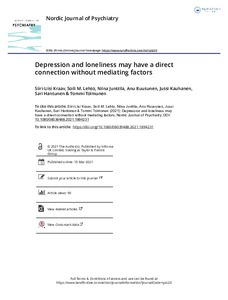Depression and loneliness may have a direct connection without mediating factors
Kauhanen Jussi; Tolmunen Tommi; Kraav Siiri-Liisi; Junttila Niina; Hantunen Sari; Ruusunen Anu; Lehto Soili M.
https://urn.fi/URN:NBN:fi-fe2021042824397
Tiivistelmä
A Brief Report
Purpose of the article
There is growing interest in loneliness and its various adverse effects on mental and physical health. While depression is one of the adverse health effects associated with loneliness, there have been some limitations in previous studies: 1) Research has mostly been carried out either in depressed patient samples or in general population samples with depressive symptoms as an outcome, 2) the follow-up times have been rather short, and 3) the mechanisms through which loneliness associates with depression are still unclear.
Materials and methods
We examined the association between loneliness and incident depression and possible mechanisms underlying this association in a population-based sample of middle-aged men (N = 2339; mean age 53; mean follow-up time 23.5 years). The association between loneliness and depression was explored with Cox proportional hazard analysis, and mediation analyses were performed with the PROCESS macro for SPSS. We used 13 health and lifestyle-related variables as covariates for adjustments in multivariate models and as mediators in simple mediation models.
Results
Those with depression as an outcome (n = 99) had significantly higher loneliness scale scores at baseline, and baseline loneliness was associated with depression, despite adjustments for potential confounding factors. No mediating factors were observed.
Conclusions
There was a strong direct association between loneliness and the incidence of depression. Based on our results, we encourage future researchers to look for possible mediators in wider range of variables.
Kokoelmat
- Rinnakkaistallenteet [19207]
